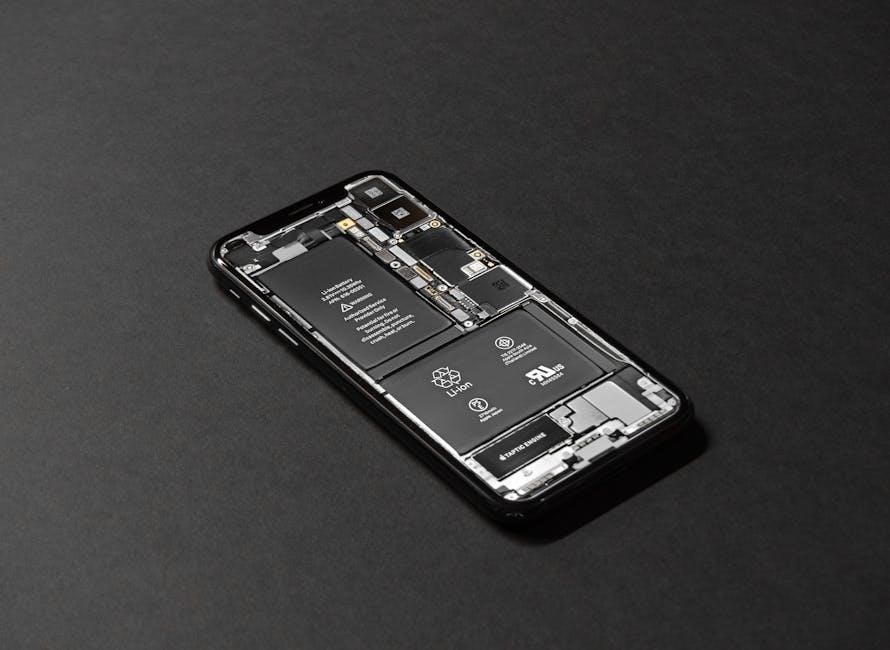savvy vape battery instructions
Understanding vape batteries is crucial for safe and optimal vaping. They power your device, and proper care ensures longevity and performance.
Key points include:
- Types of batteries vary, impacting usage and safety.
- Charging correctly prevents damage and hazards.
- Maintenance like cleaning contacts prolongs battery life.
Always follow manufacturer guidelines to avoid risks and ensure reliable operation.
1.1 Understanding the Importance of Proper Battery Care
Proper care of vape batteries is essential for safety, performance, and longevity. Neglecting maintenance can lead to reduced battery life, inefficient charging, or even safety hazards.
Key practices include avoiding overcharging, using compatible chargers, and keeping batteries away from extreme temperatures. Cleaning contacts regularly ensures reliable connections and prevents power issues.
Additionally, storing batteries properly when not in use and avoiding physical damage are critical. Following these guidelines helps maintain optimal function and minimizes risks associated with battery misuse. By prioritizing care, users can enjoy a seamless vaping experience while extending the lifespan of their devices.
1.2 Overview of Vape Battery Types
Vape batteries come in various types, each designed for specific needs. Built-in batteries are integrated into devices, offering convenience but requiring direct charging.
Removable batteries provide flexibility, allowing users to swap them and charge separately. Variable voltage batteries offer adjustable power settings, catering to different vaping preferences.
Fixed voltage models are simpler, with set power levels for consistent performance. Advanced users often opt for specialized batteries with higher capacities or unique features.
Understanding these types helps users choose the right battery for their device, ensuring compatibility and optimal performance. Proper selection enhances safety and overall vaping satisfaction. Always match the battery type to your device specifications for best results.
1.3 Why Following Instructions is Crucial for Safety
Following instructions for vape batteries is essential to ensure safety and prevent potential hazards. Misusing batteries can lead to explosions, fires, or device damage.
Always use a charger that matches your battery’s voltage and specifications. Avoid overcharging, as it can degrade the battery and pose safety risks.
Keep the device clean and dust-free to maintain proper function. Never smoked near charging batteries, as this can ignite flammable vapors.
Manufacturers provide guidelines to protect users and ensure optimal performance. Ignoring these instructions can void warranties and endanger both the user and the device.
By adhering to safety protocols, you can enjoy a seamless and risk-free vaping experience while extending the life of your battery.

Types of Vape Batteries
Vape batteries come in various forms, including built-in and removable options, with variable or fixed voltage capabilities. Each type serves specific needs, ensuring optimal performance and safety.
2.1 Built-In vs. Removable Batteries
Built-in batteries are integrated into the vape device, offering convenience and a compact design. They are often simpler to use, as they don’t require removal or separate charging.

Removable batteries, on the other hand, can be taken out and charged externally, providing flexibility and extending the device’s lifespan. They are popular among advanced users who prefer high-performance setups.
- Built-in batteries are ideal for beginners due to their ease of use and portability.
- Removable batteries suit those who need more power or prefer interchangeable options.
Choosing the right type depends on personal preference, usage habits, and the level of customization desired.
2.2 Variable Voltage vs. Fixed Voltage Batteries
Variable voltage batteries allow users to adjust the power output, enabling customization of the vaping experience. This feature is ideal for those who prefer different coil resistances or vapor production levels.
Fixed voltage batteries, however, operate at a single, unchangeable power level. They are typically more straightforward and reliable, as they lack adjustable components that could malfunction.
- Variable voltage batteries are best for experienced vapers who want control over their setup.
- Fixed voltage batteries are recommended for beginners or those seeking simplicity and consistency.
Both types have their advantages, and the choice depends on individual preferences and vaping habits.
2.3 Specialized Batteries for Advanced Users
Specialized batteries are designed for advanced vapers seeking high performance and customization. These batteries often feature adjustable voltage, wattage, and temperature control settings, catering to specific vaping preferences.
They are typically used in high-drain devices like sub-ohm tanks or rebuildable atomizers, requiring reliable power delivery. Advanced users appreciate the ability to fine-tune their settings for optimal flavor and vapor production.
- These batteries usually have multiple power modes to suit different coil configurations.
- They may include safety features like overheat protection and short-circuit prevention.
- Compatibility with various devices makes them versatile for experienced vapers.
Specialized batteries are ideal for those who demand precision and flexibility in their vaping experience, ensuring a tailored setup that meets their unique needs.

Charging Your Vape Battery
Proper charging is essential for battery longevity and safety. Use the correct charger, avoid overcharging, and monitor indicators to ensure a safe and efficient charge.
3.1 Choosing the Right Charger
Selecting the correct charger for your vape battery is vital for safety and performance. Ensure the charger matches your battery’s voltage and specifications to prevent damage.
Key considerations include:
- Compatibility with your battery type and brand.
- Checking for certifications like CE or RoHS for safety assurance.
- Avoiding universal chargers that may not fit properly.
- Using the charger provided with your device for optimal compatibility.
A well-matched charger ensures efficient charging, prevents overheating, and extends battery life. Always verify the charger’s authenticity and ratings before use. Proper charging habits start with the right equipment.
3.2 Understanding Charging Indicators
Charging indicators are essential for monitoring your vape battery’s charging status. Most chargers use LED lights to signal progress.
Common indicators include:
- Red light: Battery is charging.
- Green light: Battery is fully charged.
- Flashing lights: Indicates errors or issues.
Some chargers may also use sounds or vibrations. Always monitor the indicators to avoid overcharging.
Understanding these signals helps ensure safe and efficient charging. Refer to your charger’s manual for specific details, as indicators may vary by brand. Proper monitoring preserves battery health and performance.
3.3 Best Practices for Charging Safety
To ensure safe charging, always use the charger provided with your vape device or one specifically rated for your battery type. Avoid using fast chargers or those with higher amp ratings than recommended. Never leave your battery charging unattended or overnight, as this can lead to overcharging. Keep the charging area away from flammable materials and avoid charging in extreme temperatures. If your battery or charger shows signs of damage, discontinue use immediately. For removable batteries, place them in a protective case while charging to prevent accidental shorts. Always monitor the charging process and unplug the battery once it reaches full charge. This helps maintain battery health and prevents potential hazards.

Using Your Vape Battery Effectively
Understanding how to activate your vape and adjust settings enhances performance and safety. Learn to monitor battery health and optimize usage for longevity and consistent functionality.
4.1 How to Activate Your Vape Battery
Activating your vape battery typically involves a series of button presses. For most devices, pressing the power button five times quickly turns the battery on or off. This feature prevents accidental activation. Some vapes require three clicks to access voltage settings or other modes. Always refer to your device’s manual for specific instructions. If your vape uses a draw-activation system, simply inhale to turn it on. Ensure the battery is charged and properly connected to the tank or atomizer. If the battery doesn’t respond, check for loose connections or debris on the contacts. Proper activation ensures safe and efficient vaping. Always follow the manufacturer’s guidelines to avoid misuse.
4.2 Adjusting Voltage and Wattage Settings
Adjusting voltage and wattage settings on your vape battery is crucial for optimizing performance. Most modern devices feature adjustable settings via a control interface. Use the plus and minus buttons to increase or decrease voltage or wattage. Start with lower settings to avoid harsh hits and gradually adjust to your preference. Wattage directly impacts vapor production and battery life, so balance is key. Always refer to your device’s manual for specific instructions, as mechanisms vary. Some vapes allow custom curves or temperature control for advanced users. Remember, higher settings drain the battery faster. Experiment cautiously to find your ideal configuration without exceeding the coil’s recommended range. Proper adjustment enhances flavor, vapor, and overall vaping experience while ensuring safety.
4.4 Understanding Battery Life and Performance
Battery life and performance are critical for a seamless vaping experience. The lifespan of your vape battery depends on usage patterns, settings, and charging habits. Higher wattage and voltage settings drain the battery faster, while lower settings conserve energy. To maximize performance, avoid extreme temperatures and ensure proper charging. Overcharging or undercharging can degrade battery health. Most vape batteries last 6 to 12 months with normal use. Signs of aging include reduced vapor production and slower charging. Replace the battery if it no longer holds a charge or performs inconsistently. Regular maintenance, like cleaning contacts, also improves performance. Balancing usage and care extends battery life, ensuring consistent and enjoyable vaping sessions. Monitor your battery’s behavior to maintain optimal functionality and safety.

Maintenance and Cleaning
Proper maintenance and cleaning are essential for prolonging vape battery life and ensuring safe, efficient performance. Regularly clean battery contacts to prevent residue buildup and corrosion.
5.1 Cleaning the Battery and Contacts
Cleaning your vape battery and its contacts is crucial for maintaining performance and safety. Use a soft, dry cloth or a cotton swab to gently remove dirt, oil, or residue from the battery terminals. For tougher grime, lightly dampen the cloth with water or isopropyl alcohol, but ensure no moisture seeps into the battery. Avoid harsh chemicals, as they can damage the battery’s finish or compromise its functionality. Regular cleaning prevents corrosion and ensures a stable connection between the battery and the device. Always allow the battery to dry completely before reusing it. By keeping your battery and contacts clean, you can prevent electrical issues and extend the life of your vape battery. This simple maintenance step is essential for optimal performance and safety.
5.2 Storing Your Battery Properly
Proper storage is essential to maintain your vape battery’s health and safety. Always store batteries in a cool, dry place, away from direct sunlight and moisture. Use a protective case or sleeve to prevent physical damage and accidental activation. Avoid storing batteries in extreme temperatures, such as cars or bathrooms, as this can degrade performance. Keep batteries away from metal objects, as they can cause unintended electrical connections. Store batteries with a partial charge (around 40-50%) to maintain their health, especially for extended periods. Never stack batteries on top of each other, as this can cause pressure and damage. By following these guidelines, you can ensure your vape battery remains safe and functional for a longer period.
5.3 Signs Your Battery Needs Replacement
Knowing when to replace your vape battery is crucial for safety and performance. If your battery shows visible damage, such as dents, cracks, or rust on the contacts, it’s time to replace it. A significant decrease in performance, like weaker vapor production or shorter sessions, indicates degraded capacity. If the battery no longer holds a charge or takes much longer to charge, it’s nearing the end of its life. Overheating during use or charging is another red flag. Leaks, swelling, or unusual smells also signal that the battery should be replaced immediately. Always prioritize safety and performance by replacing your battery when these signs appear. Regular inspections can help you identify these issues early and avoid potential hazards.

Safety Precautions
Prioritize safety by never leaving charging batteries unattended, avoiding extreme temperatures, and keeping them away from metal objects. Never use damaged batteries, as this can lead to dangerous malfunctions.
6.1 Avoiding Overcharging
Avoiding overcharging is critical to ensure vape battery longevity and safety. Overcharging can cause batteries to degrade faster, overheat, or even fail. Always monitor your battery’s charge level and disconnect it once it reaches 100%. Use a high-quality charger with built-in safety features, such as automatic cutoff, to prevent overcharging. Avoid charging your vape battery overnight, as this increases the risk of exceeding the recommended charge time. Keep the device away from flammable materials while charging. Check the manufacturer’s guidelines for the recommended charging duration and voltage. Never leave a charging battery unattended, as unexpected issues can arise. By following these steps, you can significantly reduce the risk of overcharging and maintain your vape battery’s performance and safety.
6.2 Preventing Battery Damage from Extreme Temperatures
Extreme temperatures can significantly damage vape batteries, affecting their performance and lifespan. Avoid exposing your battery to direct sunlight, hot cars, or open flames, as high heat can cause swelling or failure. Similarly, cold environments, such as freezing temperatures, can reduce battery capacity temporarily. Store your vape battery in a cool, dry place, away from extreme temperature fluctuations. If your battery is exposed to cold, allow it to warm up naturally before use. Never charge a battery that has been in extreme temperatures without letting it return to room temperature first. Using a protective case or pouch can also help shield your battery from environmental extremes. By maintaining a stable temperature, you can preserve your battery’s health and functionality.
6.3 Safe Handling of Batteries
Proper handling of vape batteries is essential to ensure safety and longevity. Always avoid touching the positive and negative terminals simultaneously, as this can cause a short circuit. Never expose batteries to open flames, sparks, or hot surfaces. When carrying spare batteries, store them in a protective case or pouch to prevent accidental activation or contact with metal objects, which can cause unintended discharge or damage. Avoid over-tightening the battery when connecting it to the device, as this may strip the threads. Additionally, keep batteries out of reach of children and pets to prevent accidental ingestion or misuse. By following these guidelines, you can minimize risks and maintain optimal battery performance.

Troubleshooting Common Issues
Identify and resolve common vape battery issues, such as charging problems or connectivity errors, by checking connections, cleaning contacts, and ensuring proper usage and maintenance practices;
7.1 Fixing a Battery That Won’t Charge
If your vape battery won’t charge, start by ensuring the charger and cable are functional. Try using a different charger or cable to rule out issues. Clean the battery contacts with isopropyl alcohol to remove dirt or corrosion. Check if the battery works in another device to identify if the problem lies with the battery itself. Avoid using damaged cables or chargers, as they can prevent proper charging. If the issue persists, consider replacing the battery, especially if it’s old or has signs of wear. Always use compatible chargers to maintain safety and performance. If none of these steps work, contact the manufacturer or a professional for assistance. Proper care ensures longevity and reliable function.
7.2 Resolving Connectivity Problems
Connectivity issues with your vape battery can often be resolved with simple troubleshooting. First, ensure the battery contacts are clean and free of debris. Use isopropyl alcohol to wipe down the terminals and let them dry completely before reconnecting. If the battery doesn’t recognize the charger, try a different charging cable or port to rule out cable damage. Check if the battery is fully discharged, as some chargers won’t connect if the battery has no remaining charge; Inspect the charger’s pins for alignment or damage; bent pins can prevent proper connection. If the issue persists, attempt to charge the battery in a different device or use a different charger. If none of these steps work, the battery or charger may need replacement. Always use compatible accessories to avoid connectivity problems. Regular maintenance ensures consistent performance and reliability.
7.3 Dealing with Leaks or Damage
Leaks or damage to your vape battery can pose serious safety risks and disrupt performance. If you notice any signs of leakage, immediately disconnect the battery from the device and charger. Inspect for visible damage, such as cracks or dents, which may require professional repair or replacement. For minor leaks, clean the area with a soft cloth and ensure the contacts are dry before reuse. Avoid using damaged batteries, as this can lead to further issues like overheating or failure. Store damaged batteries in a protective case away from other metal objects to prevent accidental discharge. Always purchase replacement parts from reputable manufacturers to ensure compatibility and safety. Regular inspections and proper handling can help prevent leaks and extend the lifespan of your vape battery.

Advanced Tips for Vape Battery Management
For experienced users, advanced strategies like monitoring battery health, adjusting settings, and maintaining optimal charge levels can significantly enhance performance and safety. Explore these tips to maximize efficiency.
8.1 Using an Ohm Meter for Battery Safety
An ohm meter is a vital tool for ensuring vape battery safety, measuring resistance and voltage to prevent unsafe conditions. It helps verify coil compatibility with your battery, avoiding short circuits. Regular checks can detect issues like worn-out cells or faulty wiring. By monitoring resistance, you can identify potential risks before they escalate. This prevents overheating and ensures optimal performance. Many advanced vapers rely on ohm meters to maintain safety and longevity of their devices. Always use one to test coils and batteries, especially with rebuildable atomizers. This simple step significantly reduces the risk of accidents, making it a cornerstone of responsible vaping practices.
8.2 Understanding Battery Ratings
Understanding battery ratings is essential for safe and efficient vaping. Battery ratings, such as mAh (milliampere-hour) and discharge rate (e.g., 20A), indicate performance and safety limits. Higher mAh means longer battery life, while the discharge rate determines how much power the battery can safely deliver. Always match the battery’s discharge rate to your coil’s resistance to avoid overheating or damage. Checking these ratings ensures compatibility with your vape setup. Properly rated batteries reduce the risk of malfunction and optimize performance. This knowledge helps vapers make informed choices, ensuring both safety and satisfaction. Always prioritize batteries with clear, accurate ratings for reliable operation.
8.3 Optimizing Battery Performance
Optimizing battery performance ensures longevity and consistent vaping experience. Start by using the correct voltage and wattage settings for your coil resistance. Avoid extreme temperatures, as they can degrade battery health. Regularly clean the battery contacts to prevent power issues. Monitor charge cycles—most vape batteries last 300-500 cycles. Avoid over-discharging, as it strains the battery. Store batteries properly when not in use, especially during long periods. Use a high-quality charger and avoid fast charging if possible. Balanced use and maintenance can significantly extend battery life. By following these tips, vapers can enjoy reliable performance and safety. Proper care ensures your battery operates at peak efficiency for a longer period.

Best Practices for Longevity
Ensure proper care and usage habits to extend battery life. Avoid full discharges, store batteries safely, and keep them away from metal objects to prevent short circuits. Regular maintenance and updating your knowledge on battery technology also play key roles in maximizing longevity and safety.
9.1 Avoiding Draining the Battery Completely
Avoiding full discharges is crucial for maintaining vape battery health. Lithium-ion batteries degrade faster when drained to 0% regularly, as it strains the cells. Always aim to charge your battery when it drops to around 20% capacity. This practice reduces stress on the battery and prolongs its lifespan. Additionally, avoid leaving your vape battery discharged for extended periods, as it can cause voltage drops and irreversible damage. By keeping your battery level between 20% and 80% as often as possible, you ensure optimal performance and longevity. This simple habit significantly contributes to preserving your vape battery’s overall health and reliability over time.
9.2 Keeping Your Battery Away from Metal Objects
Keeping your vape battery away from metal objects is essential for safety and functionality. Metal can cause unintended electrical shorts, potentially leading to dangerous situations like explosions or fires. Avoid carrying loose batteries in pockets or bags with coins, keys, or other metallic items. Use a protective case or pouch to store your battery when not in use; This prevents accidental contact and ensures your battery remains secure. Additionally, metal objects can scratch or damage the battery’s exterior, compromising its performance. By keeping your battery isolated from metal, you minimize risks and extend its lifespan. Always handle your vape battery with care and store it properly to maintain safety and reliability.
9.3 Updating Your Knowledge on Battery Technology
Staying informed about advancements in vape battery technology is crucial for optimal performance and safety. Battery technology continuously evolves, with improvements in energy density, safety features, and charging efficiency. Regularly updating your knowledge ensures you understand new developments, such as better thermal management systems or enhanced battery chemistries. Follow reputable sources, manufacturer updates, and reviews to stay current. This helps you make informed decisions about upgrades or replacements. Updated knowledge also allows you to adopt best practices for newer batteries, ensuring longevity and reliability. By keeping pace with technological advancements, you can enhance your vaping experience and maintain safety standards. Always prioritize learning about the latest innovations to get the most out of your vape battery.